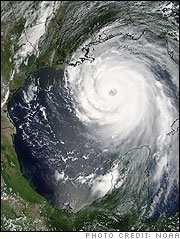Hurricane Links
Hurricane Katrina TimelineHurricane Season 2008Maps: Louisiana | Mississippi Deadliest Hurricanes in the United StatesMost Intense Hurricanes in the United StatesCostliest Hurricanes of the CenturyAtlantic Hurricane NamesRetired Hurricane NamesHurricane Advisories and WarningsU.S. HurricanesOther HurricanesEncyclopedia: HurricaneWeather & Climate
Other Great Weather Disasters
2008 DisastersWorst Weather of the Twentieth Century Weather ExtremesFloods, Avalanches, and Tidal WavesBillion-Dollar U.S. Weather Disasters
Additional Resources
From Teachervision: Resources for Students and TeachersTen Years After Hurricane Katrina: Fact Sheet
Poor and Elderly Disproportionately Affected
As most of the city’s citizens fled the city, those without cars or the financial means to relocate were left behind. The 100,000 who remained in the drowning city were largely poor and predominantly black, exposing the racial dimension of New Orleans’s persistent poverty: 28% of New Orleanians are poor (twice the national average) and 84% of those are black. The elderly poor were also disproportionately affected by the disaster: 70% of the New Orleans area’s 53 nursing homes were not evacuated before the hurricane struck.
A Natural Disaster Waiting to Happen
Hurricane Katrina has been called the most anticipated disaster in modern American history. For years, the Federal Emergency Management Agency (FEMA) had ranked New Orleans and San Francisco as the two cities most vulnerable to catastrophic natural disaster, and a day before Katrina’s landfall, the National Weather Service warned that the hurricane would cause “human suffering incredible by modern standards.”
All Levels of Government Falter
Americans were shaken not simply by the magnitude of the disaster but by how ill-prepared all levels of government were in its aftermath. Although New Orleans had performed a hurricane drill the previous year, the city and state governments had no transportation or crime prevention plans in place, and such negligence had devastating consequences.
Homeland Security and FEMA
The Department of Homeland Security, the new cabinet agency created for the very purpose of increasing domestic security, had unveiled its National Response Plan in Jan. 2005, which promised “vastly improved coordination among federal, state, local, and tribal organizations . . . by increasing the speed, effectiveness, and efficiency of incident management.” Yet Michael Chertoff, the Department’s Secretary, waited until two days after the hurricane hit before putting the plan into effect by declaring it an “incident of national significance.” Critics claimed Homeland Security’s efforts had been focused on the prevention of terrorism at the expense of preparing for natural catastrophes. Seeming not to grasp the scale of the disaster, Chertoff and Michael Brown, the director of FEMA, expressed surprise at the dangerous conditions in the convention center in New Orleans, days after its horrific images had saturated the airwaves, making them appear less informed than the average TV viewer. Brown was so inept in managing the crisis that he was quietly removed after two weeks. All three top jobs at FEMA had been filled by political appointees with no emergency management experience, and half of the agency’s senior career professionals had been cut since 2000.
The President’s Response
In sharp contrast to the leadership he displayed after the Sept. 11 terrorist attack, President Bush initially seemed off-key and out of touch, declaring that he didn’t “think anybody anticipated the breach of the levees” and waiting four days before his first brief visit to the region. Trust in the president’s ability to lead the country during a crisis had been a central factor in his reelection, but two-thirds of Americans considered his response to Katrina inadequate. To repair his image, Bush acknowledged the government’s faltering response and pledged “one of the largest reconstruction efforts the world has ever seen.”
A Year Later
A year after Katrina, the population of New Orleans was less than half of what it was before the storm hit. Nearly half the city’s hospitals remained shut and half its doctors had moved out of the area. Electricity was restored to just 60% of the city. Tens of thousands of working class African Americans, who were scattered around the country after the storm, were unable to return because neither housing nor jobs awaited them. Rebuilding efforts were chaotic and slow—with no master plan for rebuilding large-scale infrastructure. Still, more than a third of New Orleans homeowners whose houses were flooded have taken out building permits, providing a sign of hope: slowly and painfully, the city looked to be rebuilding itself.
Ten Years Later
It has been a slow and challenging rebuilding process. After one of our country’s largest exodus since the Dust Bowl, many people simply didn’t return. Having dropped by almost 350 million to 1.04 million, the New Orleans metro area population now numbers 1.252 million people. In the year after Katrina, there were more than 150,000 fewer places to live than before the hurricane hit. Since then, 115,000 housing units have been constructed, still 39,000 shy of 2005 numbers. The Mississippi coastline also reflects the impact of Katrina, experiencing an immediate population loss of more than 36,000. However, the numbers have rebounded in the past decade and today’s population now bests that of 2005 by a modest 2,700 souls. As for living arrangements, there are 4,500 more housing units today than there were before Katrina struck. Growth in hotels, restaurants, and tourism have helped the economy improve, but there still remain whole neighborhoods, abandoned, sitting in silent witness to devastation that is simply beyond repair.
